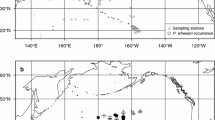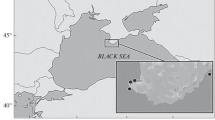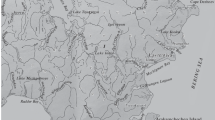Abstract
The patterns of growth and development have been studied in L. maculatus early life stages of different ecological groups (pelagic and demersal) from Kongsfjorden and Billefjorden (the northwestern coast of West Spitsbergen). It has been found that the growth rate of larvae markedly increases by age 2+ (stage L2), which is due to their transition to exogenous feeding. Consideration is given to changes in the length and condition of the lipid sac (a provisory organ) in the period of its formation, growth, and resorption in the course of ontogeny. The lipid sac reaches the maximum size at stage L4* and is resorbed at stage L5. Analysis of individual variation in the size and body weight of fish early life stages provides the possibility to evaluate the adaptation capacity of a species under specific conditions of the Arctic.
Similar content being viewed by others
References
Murzina, S.A., Role of lipids and their fatty acid components in biochemical adaptations of the daubed shanny, Leptoclinus maculatus F., from the northwestern Spitsbergen coast, Cand. Sci. (Biol.) Dissertation, Petrozavodsk, 2010.
Murzina, S.A., Nefedova, Z.A., and Nemova, N.N., Effect of fatty acids (markers of fish food sources) on mechanisms of adaptation to high-latitude conditions: A review, Tr. Karel. Nauch. Tsentra Ross. Akad. Nauk, Ser. Eksp. Biol., 2012, no. 2, pp. 18–25.
Pekkoeva, S.N., Murzina, S.A., Nefedova, Z.A., et al., Ecological role of lipids and fatty acids in the early postembryonic development of daubed shanny, Leptoclinus maculatus (Fries, 1838) from Kongsfjorden, West Spitsbergen, in winter, Russ. J. Ecol., 2017, vol. 48, no. 3, pp. 240–244.
Falk-Petersen, S., Falk-Petersen, I.-B., and Sargent, J.R., Structure and function of an unusual lipid storage organ in the arctic fish Lumpenus maculatus Fries, 1838, Sarsia, 1986, no. 71, pp. 1–6.
Meyer Ottesen, C.A., Haakon, H., Schou Christiansen, J., and Falk-Petersen, S., Early life history of the daubed shanny (Teleostei: Lepticlinus maculatus) in Svalbard waters, Mar. Biodiv., 2011, vol. 41, no. 3, pp. 383–394.
Murzina, S.A., Meyer Ottesen, C.A., Falk-Petersen, S., et al., Oogenesis and lipids in gonad and liver of daubed shanny (Leptoclinus maculatus) females from Svalbard waters, Fish Physiol. Biochem., 2012, vol. 38, no. 5, pp. 1393–1407.
Pavlov, D.A., Morfologicheskaya izmenchivost’ v rannem ontogeneze kostistykh ryb (Morphological Variation in the Early Ontogeny of Teleost Fishes), Moscow: GEOS, 2007.
Meyer Ottesen, C.A., Hop, H., Falk-Petersen, S., and Christiansen, J.S., Growth of daubed shanny (Tele ostei: Leptoclinus maculatus) in Svalbard waters, Polar Biol., 2014, vol. 37, pp. 809–815.
Fahay, M.P., Early Stages of Fishes in the Western North Atlantic Ocean (Davis Strait, Southern Greenland and Flemish Cap to Cape Hatteras), vol. 2: Scorpaeniformes through Tetraodontiformes, pp. 932–1696. http://archive.nafo.int/open/fahay/p1286-1311.pdf.
Mecklenburg, C.W. and Sheiko, B.A., Family Stichaeidae Gill 1864–Pricklebacks, Calif. Acad. Sci. Annotated Checklists of Fishes, 2004, no.35.
Pravdin, I.F., Rukovodstvo po izucheniyu ryb (A Manual of Fish Studies), Moscow: Pishchevaya Promyshlennost’, 1966.
Mina, M.V. and Klevezal, G.A., Rost zhivotnykh (Animal Growth), Moscow: Nauka, 1976.
Mina, M.V., Levin, B.A., and Mironovsky, A.N., On the possibility of using character estimates obtained by different operators in morphometric studies of fish, J. Ichthyol., 2005, vol. 45, no. 4, pp. 284–294.
Ivanter, E.V. and Korosov, A.V., Elementarnaya biometriya: Uchebnoe posobie (Elementary Biometry: A Textbook), Petrozavodsk: Petrozavodsk. Gos. Univ., 2010.
Shatunovskii, M.I., Age-related changes in the structural and energy metabolism of fishes, in Biologicheskie resursy Belogo morya i vnutrennikh vodoemov Evropeiskogo Severa: Mat-ly XXVIII mezhdun. konf. (Biologicalk Resources of the White Sea and Inland Water Bodies of Northern Europe: Proc. XXVIII Int. Conf), Petrozavodsk, 2009, pp. 631–632.
Flegler-Balon, C., Direct and indirect development in fishes: Examples of alternative life-history styles, in Alternative Life-History Styles of Animals, Bruton, M.N., Ed., Dordrecht: Kluwer, 1989, pp. 71–100.
Sidelova, V.G. and Kozlova, T.A., Comparative studies on endemic cottoid fishes (Cottidae, Comephoridae) with regard to their adaptation to living in the pelagic zone of Lake Baikal, Tr. Zool. Inst. Ross. Akad. Nauk, 2010, vol. 314, no. 4, pp. 433–447.
Eastman, J.T. and DeVries, A.L., Ultrastructure of the lipid sac wall in the Antarctic notothenioid fish Pleuragramma antarcticum, Polar Biol., 1989, vol. 9, pp. 333–335.
Falk-Petersen, S., Hopkins, C.C.E., and Sargent, J.R., Trophic relationships in the pelagic, arctic food web, in Proc. 24th European Marine Biology Symposium, 1990, pp. 315–333.
Mayzaud, P. and Falk-Petersen, S., Noyon, M., et al., Lipid composition of the three co-existing Calanus species in the Arctic: Impact of season, location and environment, Polar Biol., 2016, vol. 39, no. 10, pp. 1819–1839. doi 10.1007/s00300-015-1725-9
Weydmann, A., Coelh, N.C., Serrao, E.A., et al., Pan-Arctic population of the keystone copepod Calanus glacialis, Polar Biol., 2016, vol. 39, no. 12, pp. 2311–2318.
Kal’chenko, E.I., Growth and biochemical parameters of juvenile chum salmon grown on imported foods, in Sovremennye problemy fiziologii i biokhimii vodnykh organizmov: Mat-ly mezhdun. konf. Current Problems in Physiology and Biochemistry of Aquatic Organisms: Proc. Int. Conf.), Petrozavodsk, 2004, pp. 58–59.
Karamushko, L.I., Growth, production, metabolism, and adaptations of high-latitude marine fish, Dokl. Biol. Sci., 2014, vol. 455, pp. 116–118. doi 10.1134/S0012496614020124
Froese, R.P., Growth strategies of fish larvae, ICES C.M. 1990/L, 1990, vol. 91, pp. 1–20.
Ekologo-biokhimicheskii status molodi atlanticheskogo lososya Salmo salar L. iz nekotorykh rek basseina Belogo morya (Ecological and Biochemical Status of Juvenile Atlantic Salmon, Salmo salar L., from Some Rivers of the White Sea Basin), Nemova, N.N., Ed., Petrozavodsk: Karel. Nauch. Tsentr Ross. Akad. Nauk, 2016.
Author information
Authors and Affiliations
Corresponding author
Additional information
Original Russian Text © S.N. Pekkoeva, S.A. Murzina, E.P. Ieshko, Z.A. Nefedova, S. Falk-Petersen, J. Berge, O. Lonne, N.N. Nemova, 2018, published in Ekologiya, 2018, No. 3, pp. 225–233.
Rights and permissions
About this article
Cite this article
Pekkoeva, S.N., Murzina, S.A., Ieshko, E.P. et al. Ecological Groups of the Daubed Shanny Leptoclinus maculatus (Fries, 1838), an Arcto-boreal Species, Regarding Growth and Early Development. Russ J Ecol 49, 253–259 (2018). https://doi.org/10.1134/S1067413618030074
Received:
Published:
Issue Date:
DOI: https://doi.org/10.1134/S1067413618030074




